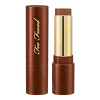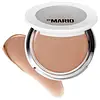Too Faced Chocolate Soleil Melting Bronzing & Sculpting Stick Versus Makeup by Mario Softsculpt Transforming Skin Enhancer
What's inside
What's inside
 Key Ingredients
Key Ingredients

 Benefits
Benefits

No benefits
 Concerns
Concerns

 Ingredients Side-by-side
Ingredients Side-by-side

Water
Skin ConditioningC12-15 Alkyl Benzoate
AntimicrobialPhenyl Trimethicone
Skin ConditioningSynthetic Wax
AbrasiveMica
Cosmetic ColorantSilica
AbrasiveDimethicone
EmollientOctyldodecanol
EmollientHydrogenated Polyisobutene
EmollientSorbitan Olivate
EmulsifyingBoron Nitride
AbsorbentDipentaerythrityl Hexa C5-9 Acid Esters
Skin ConditioningDiisostearyl Malate
EmollientCaprylyl Glycol
EmollientMethicone
EmollientSqualane
EmollientTheobroma Cacao Fruit Powder
Skin ConditioningButylene Glycol
HumectantCitrus Aurantium Dulcis Fruit Extract
MaskingPropylene Carbonate
Solvent1,2-Hexanediol
Skin ConditioningPalmitic Acid
EmollientStearic Acid
CleansingOleic Acid
EmollientArachidic Acid
CleansingCetyl Alcohol
EmollientSodium Chloride
MaskingEthylene/Propylene Copolymer
AbrasiveTriethoxycaprylylsilane
Myristic Acid
CleansingDisteardimonium Hectorite
StabilisingParfum
MaskingLimonene
PerfumingBenzyl Benzoate
AntimicrobialTocopheryl Acetate
AntioxidantCI 77891
Cosmetic ColorantCI 77491
Cosmetic ColorantCI 77492
Cosmetic ColorantCI 77499
Cosmetic ColorantWater, C12-15 Alkyl Benzoate, Phenyl Trimethicone, Synthetic Wax, Mica, Silica, Dimethicone, Octyldodecanol, Hydrogenated Polyisobutene, Sorbitan Olivate, Boron Nitride, Dipentaerythrityl Hexa C5-9 Acid Esters, Diisostearyl Malate, Caprylyl Glycol, Methicone, Squalane, Theobroma Cacao Fruit Powder, Butylene Glycol, Citrus Aurantium Dulcis Fruit Extract, Propylene Carbonate, 1,2-Hexanediol, Palmitic Acid, Stearic Acid, Oleic Acid, Arachidic Acid, Cetyl Alcohol, Sodium Chloride, Ethylene/Propylene Copolymer, Triethoxycaprylylsilane, Myristic Acid, Disteardimonium Hectorite, Parfum, Limonene, Benzyl Benzoate, Tocopheryl Acetate, CI 77891, CI 77491, CI 77492, CI 77499
C15-19 Alkane
SolventOctyldodecanol
EmollientPentaerythrityl Tetraisostearate
EmollientTridecyl Trimellitate
EmollientSynthetic Wax
AbrasiveRaphanus Sativus Seed Extract
Skin ConditioningCera Microcristallina
Emulsion StabilisingSynthetic Fluorphlogopite
Silica Silylate
EmollientMica
Cosmetic ColorantCalcium Dihydrogen Phosphate
BufferingDisteardimonium Hectorite
StabilisingTocopheryl Acetate
AntioxidantMethyl Di-T-Butyl Hydroxyhydrocinnamate
AntioxidantHelianthus Annuus Flower
Skin ConditioningRosmarinus Officinalis Leaf Extract
AntimicrobialSilicon/Titanium/Cerium/Iron Oxides
C15-19 Alkane, Octyldodecanol, Pentaerythrityl Tetraisostearate, Tridecyl Trimellitate, Synthetic Wax, Raphanus Sativus Seed Extract, Cera Microcristallina, Synthetic Fluorphlogopite, Silica Silylate, Mica, Calcium Dihydrogen Phosphate, Disteardimonium Hectorite, Tocopheryl Acetate, Methyl Di-T-Butyl Hydroxyhydrocinnamate, Helianthus Annuus Flower, Rosmarinus Officinalis Leaf Extract, Silicon/Titanium/Cerium/Iron Oxides
Ingredients Explained
These ingredients are found in both products.
Ingredients higher up in an ingredient list are typically present in a larger amount.
Disteardimonium Hectorite comes from the clay mineral named hectorite. It is used to add thickness to a product.
It can also help stabilize a product by helping to disperse other ingredients.
Hectorite is a rare, white clay mineral.
Learn more about Disteardimonium HectoriteMica is a naturally occurring mineral used to add shimmer and color in cosmetics. It can also help improve the texture of a product or give it an opaque, white/silver color.
Serecite is the name for very fine but ragged grains of mica.
This ingredient is often coated with metal oxides like titanium dioxide. Trace amounts of heavy metals may be found in mica, but these metals are not harmful in our personal products.
Mica has been used since prehistoric times throughout the world. Ancient Egyptian, Indian, Greek, Roman, Aztec, and Chinese civilizations have used mica.
Learn more about MicaOctyldodecanol is a fatty alcohol. It is primarily used to enhance the texture of products.
As an emulsifier, Octyldodecanol helps prevent the oils and waters from separating. It also prevents ingredients from creating foam when shaken.
Octyldodecanol is created by reducing fatty acid to an alcohol.
Due to its high molecular weight, it does not get absorbed into the skin.
Learn more about OctyldodecanolSynthetic Wax is created from fossil fuels such as natural gas. It is used to enhance texture, adjust pH, and as an occlusive.
It may also be used as an abrasive ingredient to exfoliate the skin.
Synthetic Wax may not be fungal acne safe.
Learn more about Synthetic WaxTocopheryl Acetate is AKA Vitamin E. It is an antioxidant and protects your skin from free radicals. Free radicals damage the skin by breaking down collagen.
One study found using Tocopheryl Acetate with Vitamin C decreased the number of sunburned cells.
Tocopheryl Acetate is commonly found in both skincare and dietary supplements.
Learn more about Tocopheryl Acetate